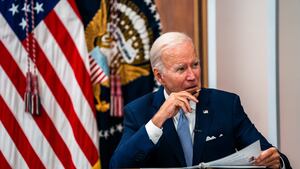President Joe Biden announced a pair of new guidances on reproductive health on Tuesday, as Democrats look to capitalize on the dissatisfaction with the aftermath of the landmark Supreme Court ruling.
The initiatives, which include a Department of Education guidance reiterating that students are protected from discrimination on the basis of pregnancy and a seven-figure grant to expand reproductive health care services, are the latest step in Biden’s slow-walking strategy on abortion rights since the high court overturned Roe v. Wade’s constitutional protections for abortion access.
Speaking from the State Dining Room of the White House alongside abortion providers and Vice President Kamala Harris, Biden called the Supreme Court’s decision in Dobbs v. Jackson Women’s Health a “fairly extreme decision,” and emphasized that in Roe’s absence, Republicans have sought to roll back abortion access nationwide.
“Republicans in Congress want to pass a law to take away the right to choose from every woman, in every state, in every county,” Biden said. “Even if you live in a state where extremist Republicans officials aren’t running the show, your right to choose will still be at risk.”
The initiatives announced on Tuesday, Biden said, are intended to tell those who need access to reproductive care that “we have your back.”
The Department of Education guidance essentially underscores pre-existing requirements that colleges and universities protect students from being discriminated against on the basis of sex, which includes discrimination on the basis of pregnancy and pregnancy termination. Some universities in states with restrictions on abortion access have stopped providing students with contraceptive medications that could be used to terminate a pregnancy, even if those medications are prescribed for other reasons.
The other initiative comes in the form of Department of Health and Human Services grants for Title X reproductive health programs. Those programs provide affordable birth control and reproductive health care—though not abortion services—to people with low incomes. Both guidances come on the heels of a report compiled by Jen Klein, director of the White House’s Gender Policy Council, which has been tasked with examining the administration’s “all-of-government” options for shielding abortion providers and patients from Dobbs.
The report found that close to 30 million women of reproductive age now live in a state with a full or partial ban on abortions—including nearly 22 million women who are barred from terminating a pregnancy after six weeks, when many do not yet know that they are pregnant.
After the unprecedented leak of the Dobbs draft opinion nearly two months before the decision officially came down, the Biden administration was an increasing target of anger and disappointment from abortion-rights advocates for what they felt was a lack of adequate preparation for a post-Roe world. Though the Biden administration repeatedly declared that it had set into motion an “all-of-government, hands-on” response to the decision, as Harris put it on Tuesday, most of Biden’s allies had no idea what that response would be.
At the time, Biden said that the administration’s White House Gender Policy Council—who were also present at Tuesday’s annoucement —would coordinate alongside the Department of Health and Human Services and the Department of Justice “to see what steps the federal government can take to ensure that women in Texas have access to safe and legal abortions,” and to examine “what legal tools we have to insulate women and providers.”
Biden released two executive orders in the weeks after Dobbs, both intended to make it easier for patients to cross state lines in order to obtain an abortion. But Biden and the administration have largely focused on the political side of the issue, saying that the only way to truly protect abortion access is to codify it in Congress—and to vote out the Republican legislators who stand in the way.
“To stop and reverse these attacks on women, we need to pass such a national law,” Harris said at the Tuesday event, crystallizing that sentiment.
Abortion-rights advocates, however, have been frustrated by the Biden administration’s “vote, vote vote” message, which comes after the White House’s rejection of proposals like expanding the Supreme Court, building abortion clinics on federal lands and declaring a national public-health emergency.
Internally, White House aides have admitted that the deliberative approach to patching what can be addressed under Dobbs is intended to serve two purposes: one, to avoid setting off legal tripwires that would trigger lawsuits against overly broad or constitutionally dubious actions; and two, to continue stoking the issue as a motivator for Democrats ahead of what are expected to be difficult midterm elections.
That approach has had a mixed reaction from voters, however. Less than one in three Americans approve of Biden’s handling of abortion, according to a Monmouth University poll released on Monday, even as the majority of Democrats say that the issue is either “very” or “somewhat” important ahead of the midterms.
The limited guidances and funding, White House press secretary Karine Jean-Pierre told reporters ahead of Biden’s remarks, are intended to make his stance on the issue clear—although she defended the administration’s slow-motion response to Dobbs.
“When the leak of the document happened, we did take action,” Jean-Pierre said, including “meeting with groups, meeting internally, trying to figure out the best way that we were going to respond.”
“The president has always taken this very seriously,” Jean-Pierre said, but ultimately, “the only way to really protect women’s health is to codify Roe.





